|
|
|||||||||
By Val Kraev
Editor's note: Kraev's Korner was first published in the newsletter of the Altshuller Institute in 2005. Our thanks to the Altshuller Institute and the Technical Innovation Center for letting us reprint this educational series. Previous lessons can be found by searching the TRIZ Journal's archives.
At the beginning of the last century different lists of inventors' recommendations were published. Each author suggested the strongest inventive rules in his personal opinion. As a result, these lists included recommendations concerning technical systems (i.e., "segmentation principle"), and advice concerning psychological aspects (i.e., "personal analogy principle") published together. The subjective character of such lists made the solving of engineering problems less efficient. They also did not allow for a formalized process of solution development. These first inventors' lists of recommendations were, therefore, limited in practical application and did not have wide circulation.
Genrikh Altshuller offered another approach to the development of inventive principles in the late 1950s. He and his colleagues selected the most often occurring strong principles based on the analysis of a large number of the patents – more than 400,000. Each of these principles efficiently "worked" in at least 80-100 inventions. As a result, 40 most often used inventor's principles were published (see following table).
| 40 Inventive Principles | |
|
The principles are the simplest TRIZ tool for resolving technical contradictions and solving problems. Their application does not require any special knowledge – children as well as professionals may use them. Nevertheless, utilization of this TRIZ tool does require some practical skills.
The contradiction table of the 40 principles was designed to formalize and to facilitate the usage of this TRIZ tool in practical activity. This table is called Altshuller's contradiction matrix. The matrix presents you with 39 system characteristics. The pairs of contradictory characteristics form a matrix. The first item in the pair is located in the left column of matrix and called the improving feature. The other item of the pair is placed in the top row of the matrix and called the worsening feature. (Not every contradictory pair of features has a set of principles associated with them.)
In practical activities, several methods of applying the principles are used during the problem solving process.
We will use examples to test each of these methods. There are two simple steps for using the inventive principles and matrix for problem solving:
First, we will apply the simplest method for solving problems using the inventive principles. This method is accomplished by scanning each principle and selecting one – or a combination of – principles, the most appropriated for solving the problem.
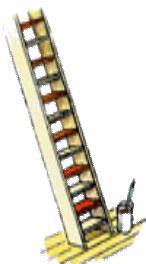 | It is impossible to climb painted wooden stairs leading to a second floor until the paint dries. How can we access the second story during the painting process?
Paint every other step and once those steps are dry, paint the remaining steps. This allows us to use the stairs without having to wait for all of them to dry. |
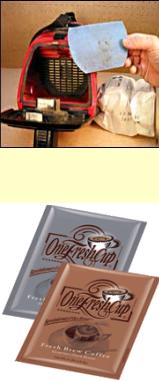 | When a vacuum cleaner is working in an enclosed space an unpleasant smell may occur. Increasing the thickness and number of external air filters in vacuum cleaner are options for avoiding the unpleasant smells. This solution, however, is not efficient because the consumption of energy increases dramatically with an increased number of filters. How can we avoid creating an unpleasant smell when vacuuming?
The best way to develop these ideas is to use the simplest and cheapest "home resource" that is always available. Before vacuuming, put a coffee bag or some other good smelling home substance (e.g., cinnamon in a bag) as an external vacuum filter. This serves as an air freshener at the same time as a filter. |
The second way to utilize the inventive principles is to use the contradiction matrix to identify a set of recommended principles to formulate a technical contradiction for the problem. The most appropriate contradictory characteristics are defined at the intersection of the horizontal rows (improving feature) and the vertical columns (worsening feature) of the matrix. The improving feature list is the concept that best describes improving the objective. The worsening feature list is the concept that best describes the corresponding deterioration in reaching the objective. In case you cannot find an exact match between the stated objective and one of the features, try finding a feature that is closely related to the objective. The description of each principle and additional hints provides clues to a solution.
The important feature of this method is determining and applying 2-4 of the recommended principles to resolve a specific technical contradiction.
 | Consider the scattered non-magnetic graphite, or magnesium powder, that needs to be cleaned. A remained after trying to use a brush. A vacuum cleaner was used, but we could not easily collect the powder from the vacuum pipe and filter after cleaning. How can this problem be fixed?
Principle 35. Transformation properties
Principle 23. Feedback
|
The third method of using the inventive principles is formulating (in advance) two reversed technical contradictions. The unique feature of this method is the use of the principles for direct and reversed contradictions to find an improved solution concept. This is reasonable because both of the reversed formulations make sense and the matrix may suggest additional effective principles for solving the problem.
|
A washing machine works pretty well for cleaning small articles of clothing. Similarly, cleaning bulky items, such as blankets, window curtains or a thick downy jacket is difficult in a standard washing machine. To clean these bulkier items, we have to use several washing cycles. This solution is imperfect because we lose time and energy without guaranteed success. What can we do to improve this situation?
Principle 34. Rejecting and regenerating parts
Both of these principles suggest using in advance new, additional object or objects that should be removed after the washing process. Before washing, put some tennis balls into the washing machine with the thick downy jacket. The tennis balls serve as mobile activators, which dynamically collide with the jacket and provide better cleaning without requiring extra washing time. |
The fourth method for using the inventive principles is applying the contradiction matrix by getting several sets of principles from different technical contradictions for the problem. They should be tested for solving problem at first because it may give extra benefit and these principles may be useful for solving several technical contradictions at the same time.
|
If you are going for a long camping trip, do not forget matches. But matches are unreliable – they do not like moisture and work poorly in the rain. You can use a waterproof plastic bag to keep the matches dry, but how can you strike a match when it is raining? The most appropriately corresponding parameters are "time of action of a moving object" (15) as the improving parameter and "reliability" (17) as the worsening characteristic of the matches. At their intersection there are three recommended principles for resolving the indicated contradiction: 11, 2 and 13.
This principle, therefore, should be tested first. In my opinion, it is the most appropriate principle for solving both contradictions. Before going on the camping trip, dip the matches in a molten candle paraffin to form a thin protective layer on the matches. The matches with protective layer of paraffin are not endangered by moisture and burn with a higher reliability in any time and weather. Thus, the application of one principle solved two different contradictions. |
As a rule, the principles themselves do not give any ready solutions. They advise and direct the solution's development. It is necessary to work with them without rushing, exploring all offered opportunities and recommendations. Sometimes it may be necessary to reformulate the initial problem to get the best-correlated principles.
Researchers and inventors thought that the further development of the inventive principles would increase the number of principles and conflicting features, but it is clear that difficult problems are solved by the simultaneous application of combinations of several principles or using the principles with physical effects. The inventive principles remain the primary tool for novice inventors and a simple and efficient TRIZ application.
The 40 principles are the simplest TRIZ tool for removing technical contradictions and solving the whole problem. The invention level of obtaining solutions, as a rule, is not of the highest order, because the solution is developed on the technical level and principles do not work on the physical level. Due to the simple structure of the contradiction matrix, applying the principles does not require special knowledge; beginners as well as professionals may use them without extensive training. The described four methods of applying the principles and matrix work with technical contradictions and each method has its own features and specific order for obtaining recommended principles. The inventor can select the necessary method, as the specific situation requires.
Which inventive principles are used in the problem solving process described below?
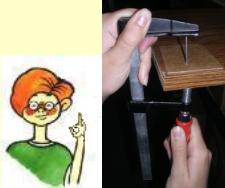 | Problem: It is not easy to nail a piece of wood to the end of a board that is not reliably supported from below. |
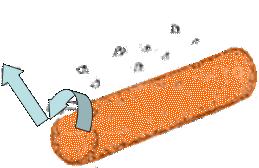 | Problem: How can we collect tiny splinters of broken glass on the floor? A vacuum cleaner and brush cannot completely clean the glass, because some tiny splinters are heavy and stick in the floor. |
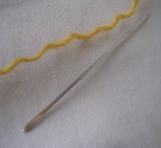 | Thick Thread Problem It is difficult to thread a needle with thick woolen thread. Even if we moisten the thread end, it remains thick and resists going through the needle's eye. |
 | Swab Problem |
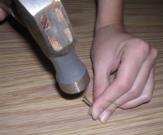 | Hammering Small Nail Problem |
Val Kraev is the chief TRIZ officer of the Technical Innovation Center in Worcester, MA, USA, and has contributed several very valuable case studies to The TRIZ Journal. Contact Val Kraev at kraev (at) triz.org or visit http://www.triz.org.